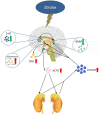The Relationship Between 5-Hydroxytryptamine and Its Metabolite Changes With Post-stroke Depression
- PMID: 35558423
- PMCID: PMC9086784
- DOI: 10.3389/fpsyt.2022.871754
The Relationship Between 5-Hydroxytryptamine and Its Metabolite Changes With Post-stroke Depression
Abstract
Post-stroke depression (PSD) is the most common and serious sequelae of stroke. Approximately 33% of stroke survivors were affected by PSD. However, many issues (e.g., incidence, diagnostic marker, and risk factor) related to PSD remained unclear. The "monoamine hypothesis" is a significant hypothesis for depression, which suggests that three monoamines play a key role in depression. Therefore, most current antidepressants are developed to modulate the monoamines on PSD treatment, and these antidepressants have good effects on patients with PSD. However, the potential mechanisms of three monoamines in PSD are still unclear. Previously, we proposed "three primary emotions," which suggested a new model of basic emotions based on the three monoamines. It may provide a new way for PSD treatment. In addition, recent studies have found that monoamine-related emotional intervention also showed potential effects in the treatment and prevention of PSD. This study discusses these issues and attempts to provide a prospect for future research on PSD.
Keywords: 5-Hydroxytryptamine; emotional intervention; monoamine hypothesis; post-stroke depression; three primary emotions.
Copyright © 2022 Gu, He, Xu, Dong, Xiao, Liang, Ma, Wang and Huang.
Conflict of interest statement
The authors declare that the research was conducted in the absence of any commercial or financial relationships that could be construed as a potential conflict of interest.
Figures


Similar articles
-
The advances of post-stroke depression: 2021 update.J Neurol. 2022 Mar;269(3):1236-1249. doi: 10.1007/s00415-021-10597-4. Epub 2021 May 30. J Neurol. 2022. PMID: 34052887 Review.
-
Pathophysiology and Current Drug Treatments for Post-Stroke Depression: A Review.Int J Mol Sci. 2022 Dec 1;23(23):15114. doi: 10.3390/ijms232315114. Int J Mol Sci. 2022. PMID: 36499434 Free PMC article. Review.
-
Post stroke depression: The sequelae of cerebral stroke.Neurosci Biobehav Rev. 2018 Jul;90:104-114. doi: 10.1016/j.neubiorev.2018.04.005. Epub 2018 Apr 12. Neurosci Biobehav Rev. 2018. PMID: 29656030 Review.
-
Pharmacological management of post-stroke depression.Expert Rev Neurother. 2020 Feb;20(2):157-166. doi: 10.1080/14737175.2020.1707666. Epub 2019 Dec 25. Expert Rev Neurother. 2020. PMID: 31860359 Review.
-
Identification of Potential Metabolite Markers for Middle-Aged Patients with Post-Stroke Depression Using Urine Metabolomics.Neuropsychiatr Dis Treat. 2020 Aug 25;16:2017-2024. doi: 10.2147/NDT.S271990. eCollection 2020. Neuropsychiatr Dis Treat. 2020. PMID: 32922015 Free PMC article.
Cited by
-
Glymphatic Dysfunction Induced Oxidative Stress and Neuro-Inflammation in Major Depression Disorders.Antioxidants (Basel). 2022 Nov 20;11(11):2296. doi: 10.3390/antiox11112296. Antioxidants (Basel). 2022. PMID: 36421482 Free PMC article. Review.
-
Advancing Post-Stroke Depression Research: Insights from Murine Models and Behavioral Analyses.Life (Basel). 2024 Sep 3;14(9):1110. doi: 10.3390/life14091110. Life (Basel). 2024. PMID: 39337894 Free PMC article. Review.
-
Eye movements and ERP biomarkers for face processing problems in avoidant attachment-style individuals.Front Behav Neurosci. 2023 May 19;17:1135909. doi: 10.3389/fnbeh.2023.1135909. eCollection 2023. Front Behav Neurosci. 2023. PMID: 37273280 Free PMC article.
-
Xiangshao Granules Ameliorate Post-stroke Depression by Inhibiting Activation of Microglia and IDO1 Expression in Hippocampus and Prefrontal Cortex.Chin J Integr Med. 2025 Jan;31(1):28-38. doi: 10.1007/s11655-024-3903-5. Epub 2024 Oct 2. Chin J Integr Med. 2025. PMID: 39356429
-
Association Between Sleep and Vertigo Severity in Benign Paroxysmal Positional Vertigo: Mediating Role of Psychological Factors.Nat Sci Sleep. 2025 Jun 23;17:1477-1490. doi: 10.2147/NSS.S529355. eCollection 2025. Nat Sci Sleep. 2025. PMID: 40584285 Free PMC article.
References
Publication types
LinkOut - more resources
Full Text Sources

